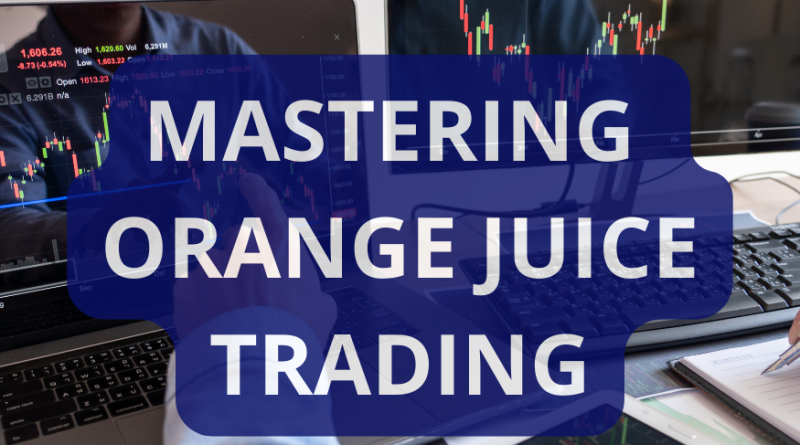Orange juice is not just a breakfast staple; it is also a significant commodity in the trading market. As a soft commodity, orange juice is subject to a variety of market forces that can make its price highly volatile. For traders, understanding these dynamics is crucial for success. From the economics of supply and demand to the specific trading hours and price determinants, mastering orange juice trading requires a comprehensive approach. This guide aims to provide an in-depth look at the essential aspects of orange juice trading to help traders navigate this unique market.
Understanding orange juice trading
Orange Juice Commodity Trading:
Orange juice trading involves buying and selling futures contracts and options on the price of orange juice. These trades typically occur on exchanges like the Intercontinental Exchange (ICE). The significance of orange juice trading in the commodity market stems from its economic impact on agricultural sectors and its sensitivity to various factors, making it a dynamic and potentially profitable venture. Traders must understand how futures contracts work, including the specifics of contract sizes, expiration dates, and the implications of physical delivery versus cash settlement.
Orange Juice Trader:
An orange juice trader specializes in the buying and selling of orange juice futures and options. The role requires a deep understanding of market trends, economic indicators, and technical analysis. Traders must be adept at using trading platforms, interpreting market data, and executing trades efficiently. Additionally, they need to be aware of regulatory requirements and risk management strategies to protect their investments. Successful orange juice traders combine analytical skills with a keen intuition for market movements, staying informed through continuous education and market monitoring.
Economics of orange juice trading
Orange Juice Trading Economics:
The economics of orange juice trading is influenced by several factors, primarily supply and demand dynamics. The supply side is affected by the yield of orange groves, which can fluctuate based on weather conditions, diseases such as citrus greening, and production costs. On the demand side, consumer preferences, global market trends, and economic indicators like disposable income and health trends play a significant role. Understanding these factors helps traders anticipate price movements and make informed decisions.
Impact of External Factors:
Weather conditions are a major influence on orange juice production. Hurricanes, droughts, and unexpected frosts can devastate crops, leading to reduced supply and increased prices. Diseases affecting orange trees, such as citrus greening, also pose significant risks to production levels. Additionally, geopolitical events, such as trade disputes or changes in tariffs, can impact the availability and cost of oranges, thereby affecting the market. Traders must stay vigilant and responsive to these external factors to mitigate risks and capitalize on market opportunities.
By understanding these fundamental aspects of orange juice trading, traders can better navigate the complexities of the market, making strategic decisions that enhance their chances of success.
Orange juice trading hours
Overview of the Trading Hours for Orange Juice Futures and Options:
The trading hours for orange juice futures and options are crucial for market participants. Typically, these contracts are traded on the Intercontinental Exchange (ICE), which has specific trading sessions. For orange juice futures, trading usually begins at 8:00 AM and ends at 2:00 PM Eastern Time (ET). However, it is essential to check the current schedule on the ICE website or through a broker, as trading hours can occasionally change due to holidays or special market conditions.
Importance of Being Aware of the Trading Hours for Effective Market Participation:
Knowing the trading hours is vital for effective market participation. It allows traders to plan their trading activities, monitor the market during active hours, and execute trades at optimal times. Awareness of trading hours also helps in managing risk, as price volatility can vary significantly throughout the trading session. Being attuned to market opening and closing times ensures that traders do not miss critical opportunities or get caught off guard by sudden market movements.
Differences Between Trading Hours on Various Exchanges (e.g., ICE Futures U.S.):
Different exchanges may have varying trading hours for similar commodities. For example, while ICE Futures U.S. is the primary exchange for orange juice futures, other commodities might trade on exchanges with different schedules. It is important for traders to familiarize themselves with the specific trading hours of each exchange they are involved in to coordinate their trading activities effectively. Understanding these differences helps in maximizing market opportunities and aligning trading strategies with market timings.
Analyzing orange juice trading prices
Orange Juice Trading Price:
Several factors influence the price of orange juice, making it essential for traders to stay informed about these variables. Key influencers include:
- Seasonal patterns: Orange juice prices often follow seasonal trends, with prices typically rising during off-season periods when supply is lower.
- Crop reports: Regular updates on orange crop yields, health, and expected production volumes can significantly impact prices.
- Economic indicators: Broader economic trends, such as consumer spending habits, health trends, and changes in disposable income, also affect orange juice demand and pricing.
Tools and Methods for Analyzing Orange Juice Prices:
- Technical analysis: Utilizing chart patterns, moving averages, and other technical indicators to predict future price movements based on historical data.
- Fundamental analysis: Examining underlying factors such as weather reports, crop health, and global demand-supply dynamics to assess the intrinsic value of orange juice futures.
- Market sentiment indicators: Gauging the overall mood of the market through sentiment analysis tools, trader positioning data, and news sentiment to anticipate potential price shifts.
Strategies for successful orange juice trading
Key Strategies for Trading Orange Juice Futures and Options:
- Hedging: Using futures contracts to protect against price volatility in the orange juice market. Producers and consumers often hedge to lock in prices and stabilize revenue or costs.
- Speculation: Traders speculate on the direction of orange juice prices to profit from market movements. This involves taking positions based on price predictions derived from various analyses.
- Arbitrage: Exploiting price differences between related markets or contracts to generate profit. This can involve buying and selling orange juice futures across different exchanges or contract months.
Risk Management in Orange Juice Trading
Importance of Risk Management in Commodity Trading:
Risk management is a cornerstone of successful trading, especially in the volatile commodity markets like orange juice. Effective risk management strategies protect traders from significant losses, ensure long-term sustainability, and help in maintaining a balanced approach to trading. Given the susceptibility of orange juice prices to sudden changes due to weather conditions, diseases, and geopolitical events, having a robust risk management plan is crucial.
Techniques for Managing Risk:
- Setting stop-loss orders: Implementing stop-loss orders is a fundamental risk management technique. It involves setting a predetermined price at which a trade will automatically be closed to prevent further losses. This ensures that traders can limit their losses on unfavorable trades.
- Diversifying portfolios: Diversification involves spreading investments across different assets or markets to reduce exposure to any single asset’s volatility. In the context of orange juice trading, this could mean diversifying into other commodities or financial instruments.
- Using futures contracts for hedging: Hedging with futures contracts allows traders to lock in prices and mitigate the risk of adverse price movements. For example, an orange juice producer might use futures contracts to secure a selling price for their product, protecting against potential price drops.
Practical Tips for Aspiring Orange Juice Traders
Tips for Staying Informed About Market Trends and Developments:
- Regularly read market reports: Keeping up with the latest market reports and crop forecasts provides valuable insights into supply and demand dynamics.
- Monitor weather conditions: As weather significantly impacts orange juice production, staying informed about weather forecasts and conditions in major orange-growing regions is essential.
- Follow economic indicators: Understanding broader economic trends and consumer behavior helps in predicting market movements.
Recommended Resources:
- Market reports: Accessing reports from sources like the USDA, and industry-specific publications provides critical data and analysis.
- Trading platforms: Using robust trading platforms that offer real-time data, charting tools, and news feeds helps traders make informed decisions.
Conclusion
The orange juice market, like all commodity markets, is dynamic and influenced by numerous factors. Continuous learning and adaptability are vital for staying ahead. By keeping abreast of market trends, economic indicators, and weather conditions, traders can navigate this volatile market with confidence.

